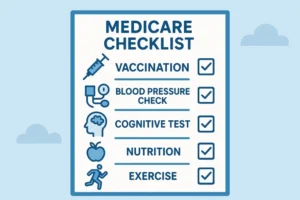Preventive care is one of the most important aspects of your health. The Medicare annual wellness visit exam is a yearly appointment that reviews the patient’s personalized prevention plan.
The Medicare annual wellness visit (AWV) is a proactive approach that significantly improves quality of medical care. If you’re new to Medicare, we will guide you through the enrollment process, what is included, who is eligible, and how Medicare covers the visit. Here is what you need to know.
What is a Medicare Wellness Visit?
The annual Medicare wellness visit is a yearly appointment with your primary care physician (PCP) to create a new or update your personalized prevention plan. Please note, a Medicare wellness exam is not a head-to-toe physical exam; it is an encounter to discuss and update preventive services.
The visit focuses on reviewing health history, risk assessment, preventive service planning, and recommended screenings. This annual visit is also an opportunity to address concerns affecting your activities of daily living and quality of life.
Medicare Annual Wellness Visit Requirements
In order to meet the requirements of Medicare annual wellness visits, you must have completed the “Welcome to Medicare” preventive visit. Other AWV requirements include:
- You have Medicare Part B (or a Medicare Advantage plan) and be >12 months from your Part B start date for your first AWV.
- You haven’t had IPPE (“Welcome to Medicare”) or another AWV in the last 12 months.
- Subsequent AWVs are available once every 12 months.
Key Components of Annual Wellness Visits
There are several key components of an annual wellness visit to address your current health concerns, mental health, cognitive function, review of your present medication, and care plan. AWV is designed by the Centers for Medicare and Medicaid Services. There is a primary set of general rules:
- AWVs can only be performed for eligible Medicare beneficiaries by one provider, one time a year.
- Medicare beneficiaries are not responsible for paying coinsurance, copayment, and Part B deductible for the Medicare AWV
- In order to start with the AWV program, your provider will need to perform the basic eligibility check to ensure you’re qualified for the medical wellness exam program.
Covered Services & Costs
The Medicare wellness exam is a Medicare Part B-covered preventive service. The core elements of the visit are covered at no coinsurance and no deductible when performed by a provider who accepts Medicare assignment. The AWV’s covered elements include:
- Height, weight, blood pressure, and other routine assessments
- Questionnaire for health risk assessment to include a fall risk and pain assessment questionnaires.
- Evaluation of functional and cognitive ability
- Review of medical and family history
- Health education on weight loss, physical activity, smoking cessation, fall prevention, nutrition, and more.
Health Risk Assessment (HRA)

The AWV is different from the routine annual physical visit. The AWV is more focused on preparing and updating the patient’s Health Risk Assessment (HRA). The HRA consists of a series of questionnaires about the patient’s current health, lifestyle habits, and medical history.
From the responses to the HRA questionnaire, the providers are able to assess risk factors and prepare a suitable preventive plan.
Review of Medical and Family History
A thorough review of your medical and family medical history will be conducted. This helps identify hereditary risks and patterns of chronic conditions, cognitive health and mental health.
Checklist for Preventive Services

The visit ensures you are up to date with preventive services such as vaccinations, screenings, and lab work, in compliance with Medicare wellness exam requirements.
Functional Ability Test
A functional ability test is required to assess a patient’s cognitive and social functioning. It assists in evaluating patients’ mobility, sensory activities, and executive function, such as maintaining hygiene and preparing small meals.
Advance Care Planning
The AWV also offers advance care planning for patients who need help to secure their future medical well-being. It involves making note of the patient’s end-of-life care wishes and advance directives.
Personalized Prevention Plan
You will leave with personalized health advice on activity, nutrition, managing risk factors, referrals, and orders as needed.
Benefits of the Medicare Annual Wellness Visit
- Early detection of risk factors
- Ensure that you are up-to-date with the recommended vaccinations and screenings
- A personalized plan that turns recommendations into an actionable healthcare strategy
- $0 out-of-pocket for the AWV itself when your provider accepts assignment; separate costs may apply for non-covered add-ons performed the same day
How to Prepare for an Annual Wellness Exam?
- Bring a list of your ongoing medications (prescriptions, OTCs, supplements)
- Bring an updated history (medical, family, surgeries) and immunization.
- List your priorities, such as caregiving needs, lifestyle goals, symptoms, memory concerns, and any others.
Who can perform a Medicare Annual Wellness Visit?
Medicare allows a range of professionals to provide the AWV:
- Physicians (MD/DO)
- Qualified non-physician practitioners (physician assistants, nurse practitioners, certified clinical nurse specialists)
- A medical professional (e.g., health educator, registered dietitian, nutrition professional, or other licensed practitioner) or a team of such professionals under a physician’s direct supervision.
Medicare Annual Wellness Exam vs Physical Exam
Medicare wellness exam vs a physical exam is a common point of confusion:
Medicare Annual Wellness Exam (AWV):
It’s prevention-focused; includes HRA, medical histories, cognitive assessment, screening schedule, and personalized advice. No head-to-toe comprehensive physical or diagnostic checkup.
Routine Physical Exam:
A head-to-toe exam is performed without relation to a specific complaint. Though some elements are covered within IPPE/AWV, Medicare doesn’t cover routine physicals; patients pay 100% out-of-pocket for routine physicals.
Conclusion:
The Medicare annual wellness visit is the centerpiece of preventive services. It equips patients with a personalized plan, aligns them with the right screenings. The plan includes regular check-ups for cognition, mood, safety, and social needs. Schedule it yearly; use it to set health goals and close preventive care gaps.
FAQs:
Q1: What is a Medicare wellness visit?
Ans: A Medicare wellness visit is a yearly health checkup. It’s focused on offering a preventive treatment plan where your provider reviews medical history, lifestyle, and risks, performs screenings, and creates a personalized plan.
Q2: Is a Medicare wellness exam mandatory?
Ans: No, the exam is not mandatory; however, it’s advised to get checked yearly. Taking advantage of the Medicare annual wellness visit ensures you receive preventive care with personalized health planning.
Q3: Can you refuse a Medicare wellness visit?
Ans: Yes. Appearing for the Medicare wellness visit completely depends on your choice. Though it’s optional, skipping it means missing out on personalized prevention plans and free services benefits included with the annual wellness.
Q4: What are the Medicare wellness exam requirements?
Ans: The Medicare wellness exam requirements include being enrolled in Medicare Part B for at least 12 months. Patients are required to have a Medicare Annual Wellness Visit every 12 months. They should fulfill basic visit requirements, such as completing a health risk assessment.
Q5: Does Medicare pay for a physical?
Ans: No. Routine physical exams are not included in the Medicare plans.

